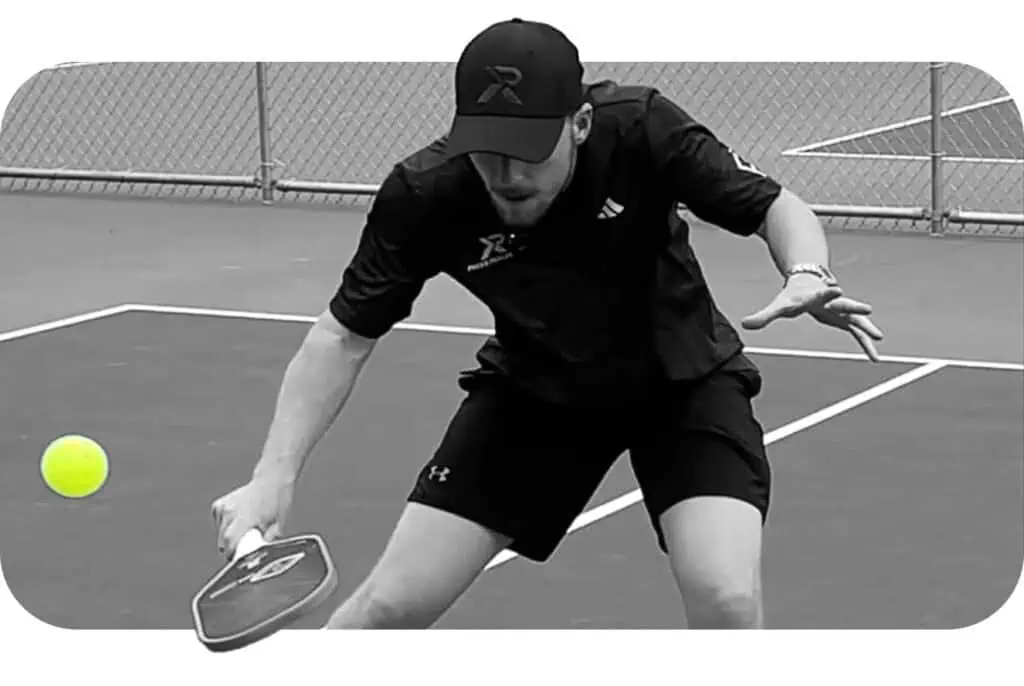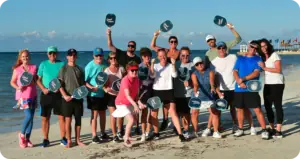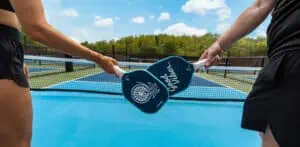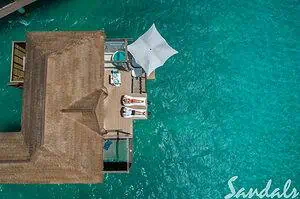Pickleball
How to Increase Your Pickleball Reaction Time: Top Skills and Drills

Whether you’re a pickleball newbie or a seasoned player, one thing is clear: reaction time can make or break your game. Picture yourself on the court, facing an aggressive opponent whose every shot seems to come at lightning speed. If your mind and body aren’t in sync for a quick response, you might find yourself scrambling instead of scoring points. That’s where understanding and improving your reaction time comes into play. By focusing on specific skills and practicing targeted drills, you can boost your responsiveness and stay competitive against sharp players. Let’s explore how to sharpen those reflexes and take your game to the next level!
To increase your pickleball reaction time, incorporate drills that focus on quick hand-eye coordination, such as wall ball exercises and shadow drills, which help sharpen your reflexes. Additionally, regular practice sessions—ideally 2-3 times a week—can significantly improve your overall timing and skill in anticipating opponents’ moves. Engaging in dedicated clinics during all-inclusive pickleball vacations can further refine these techniques under professional guidance.
The Basics of Reaction Time in Pickleball
In the fast-paced world of pickleball, reaction time is not just a minor detail; it is often the defining factor that determines the outcome of a point. Simply put, reaction time refers to how quickly you can respond to an external stimulus—like the serve or volley coming from your opponent. Imagine being caught off guard by a well-aimed spike; it’s frustrating and can lead to costly errors. Thus, sharpening this skill becomes imperative for every aspiring player, especially those looking to defend against stronger competitors.
One significant aspect influencing reaction time is how efficiently our neural pathways operate. Think of your brain as a supercomputer that processes information and relays commands to your muscles. The faster you can digest information—like anticipating where the ball will land—the quicker you’ll be able to move and position yourself effectively on the court. It’s fascinating to note that, on average, top athletes exhibit reaction times as low as 150 milliseconds! That’s less than a blink of an eye! For recreational players, mastering quicker decision-making can drastically improve performance during matches.
Sports science research indicates that skilled athletes typically process visual stimuli and react within 250 milliseconds, but consistent practice and experience can chip away at this number. Regular engagement in games helps players develop faster reflexes as muscle memory kicks in. As you play more, your body becomes attuned to common movements and patterns, making it easier to respond without overthinking each action.
A captivating scenario involves observing elite players in tennis or table tennis who achieve reaction times below 200 milliseconds. This remarkable speed stems not just from natural talent but is honed through specialized training regimens focused on enhancing dexterity and agility. They incorporate direct drills that challenge their hand-eye coordination while expecting quick reactions from various angles on the court.
Consider joining us at VibeGetaways. Engaging in our pickleball vacation packages opens doors to tailored coaching and focused practice on vital skills such as refining your reaction time. With structured sessions led by seasoned professionals, you’ll have opportunities to apply drill strategies that sharpen both your mind’s acuity and your physical responses during gameplay.
There’s no doubt that improving reaction times requires dedication and practice. By embracing these exercises, you’ll be well on your way to elevating your game and enhancing your overall agility on the court.
Hand-Eye Coordination Drills
At the heart of pickleball lies hand-eye coordination, a skill that can mean the difference between returning a tricky shot or watching the ball sail past you. One effective drill to sharpen this coordination is the Ball Toss and Catch. In this exercise, you’ll have a partner toss a small ball towards you; the catch here—pun intended—is to use alternating hands for catching, which helps develop ambidexterity as well. As your comfort grows, increase the difficulty by varying the speed and angle of the tosses. This simple yet powerful drill not only reinforces your catching technique but also enhances peripheral vision and rapid response.
Interestingly enough, many professional pickleball players incorporate variations of this drill into their routines before high-stakes matches, demonstrating its importance across skill levels.
Once you’ve established a solid base with basic hand-eye coordination, it’s essential to utilize a variety of other drills to build on those skills and apply them in more dynamic environments.
Reaction Ball
Next up is the Reaction Ball Drill, which promises to raise your reaction time significantly. This special ball bounces unpredictably, so when you throw or drop it against a surface—it’s perfect for training! The objective is simple: catch it as it zips away in various directions. Just imagine that little burst of adrenaline every time you make a catch; you’ll feel yourself getting quicker with each session. Studies indicate that consistently performing this drill can lead to a 25% increase in overall reaction time within just six weeks—a statistic that speaks volumes for your competitive edge on the court.
These drills are fantastic for solo practice when you don’t have a partner available; however, incorporating team-based drills can offer new insights and leverage real-game dynamics.
Partner Mimicking
Consider engaging in Shadowing Drills—this involves your partner mimicking various movements while you react accordingly. By having them simulate different shots and footwork patterns, you’ll boost your visual tracking abilities as well as learn to anticipate your opponent’s actions. It’s kind of like playing cat and mouse but with purposeful training behind it. Research shows this form of drill enhances visual acuity and reaction times by about 20% in just three weeks!
Regular practice of these partnered drills fosters an understanding of spacing and timing—which are crucial when you’re eventually up against live competition.
As you integrate these techniques into your routine, you’ll not only see improvements in your reaction times but also develop deeper gameplay intuition, paving the way for greater success on the court ahead.
Strengthening Core Pickleball Skills
When it comes to becoming a proficient pickleball player, core skills go beyond simply understanding the rules of the game; they are crucial for developing a strong foundation upon which advanced techniques can be built. One of the most effective ways to strengthen these skills is through focused drills that target specific aspects of your gameplay. For instance, the dink volley exercise requires engaging with a partner and practicing soft, controlled shots to refine your precision. This activity emphasizes not only accuracy but also enhances your reaction time, as frequent engagement in this drill compels you to respond quickly to a partner’s positioning.
Just imagine yourself playing side-by-side with someone who challenges your ability to keep the ball low and maneuver deftly at the net. It’s like refining your art; by concentrating on those delicate touches and maintaining control, you cultivate muscle memory that makes every subsequent response quicker and more instinctive. The beauty of repetitive practice here lies in its simplicity—by returning to these basics regularly, your game grows stronger in complexity and agility simultaneously.
As we explore additional drills, consider how each one contributes uniquely to building specific skills necessary for exciting matches or competitive play.
Reaction Ball Drill
Another brilliant exercise is the reaction ball drill, utilizing a small bouncy ball with an irregular shape. You bounce this ball against a wall and scramble to catch it as it rebounds unpredictably. This drill emphasizes alertness, footwork, and hand-eye coordination. A mere ten minutes spent on this can significantly sharpen your reflexes and response times. It establishes the kind of quick decision-making that comes into play during high-pressure rallies.
Think of it this way: each unpredictable bounce is akin to an opponent’s shot—often unexpected! By training with this method, you’re preparing yourself for game situations where a sudden spike or drop can require immediate action.
In fact, many players have reported noticeable improvements after consistently incorporating such drills into their routines. One participant shared how practicing reaction drills transformed their gameplay during competitive matches, allowing them to anticipate their opponent’s actions better while simultaneously improving their own serving abilities.
Each training session represents an opportunity for improvement, culminating in enhanced performance on the court.
Partner Drills
Finally, partner drills should be part of your skill-building arsenal. Having an experienced partner allows you to engage in back-and-forth gameplay while focusing on aspects like anticipating moves and adjusting your positioning accordingly. Your reactions naturally become sharper when forced to predict where the ball will land based on visual cues from your partner’s stance and swing dynamics.
Pickleball isn’t just about hitting the ball—it’s about reading the game. These practice sessions foster not only technical capabilities but also strategic thinking, which is critical in competitive settings. As you learn from one another, feedback becomes an invaluable tool. An experienced partner may offer insights regarding timing or positioning that you might not have considered previously.
At VibeGetaways, we prioritize these elements in our all-inclusive pickleball vacations, ensuring players not only enjoy recreational time but also engage in structured practices that will sharpen essential skills needed for both casual play and tournament readiness.
With every focused drill and practice session, you’re enhancing not just your reaction time but also preparing yourself for dynamic movement and swift responses on the court. Let’s transition to consider how various enhancements in agility and footwork can further elevate your gameplay!
Agility and Footwork Enhancements
In pickleball, agile footwork is like having a secret weapon. It allows you to not only react more swiftly to your opponent’s shots but also positions you optimally for your return. The fundamental aspect of enhancing agility lies in the ability to move laterally and quickly change directions. This is where specific drills play a crucial role.
Cone Shuffle
One highly effective drill is the Cone Shuffle. To set this up, arrange a series of cones in a zig-zag pattern about five to ten feet apart. Stand at the first cone and when you’re ready, shuffle methodically to touch each cone with your hand before moving on to the next one. This drill trains your body to respond quickly while keeping balance and control during lateral movements. Spend about 10-15 minutes on this drill, and you will feel noticeably faster.
“Engaging your core while performing these shuffles not only enhances stability but also prevents injuries, keeping you in the game longer.”
After you’ve gotten comfortable with the Cone Shuffle, ramping up the intensity is essential. Maintaining the mindset that practice makes perfect is crucial because consistent repetition leads to muscle memory development.
Incorporating Speed Drills
Enhancing your agility creates a strong foundation; however, to be swift, focus on pure speed.
Consider adding Lateral Quickness Drills into your routine once or twice a week. For this exercise, line up against a wall or net; from the starting position, practice quick side shuffles back and forth over a specified distance, taking short steps rather than big strides. Incorporating agility drills such as these can improve reaction times by up to 20%, according to studies published in the Journal of Sports Science.
Jump Rope Interval Training
Another exhilarating way to enhance both foot speed and stamina is through Jump Rope Interval Training. Try doing sets of one minute of jumping followed by 30 seconds of rest. Not only does this condition your cardiovascular system, but it also teaches you how to adjust your feet quickly according to changing rhythm—an essential skill during gameplay when swiftness can lead to advantageous positioning.
Remember that consistency is key. Aim for 2-3 specific agility training sessions per week and gradually increase their duration as you become more proficient. Combining these drills within your regular pickleball practice will develop your footwork and help build confidence as you become more aware of your movement capabilities.
As you refine these essential skills, it’s time to explore methods that will push your limits further and elevate your performance even more effectively.
Quickness and Speed Workouts
Speed in pickleball isn’t just about running fast; it’s a combination of technique, strength, and timing. Imagine the rush of capturing that perfect shot just as it comes flying toward you—it requires a robust reaction time along with sharp foot speed. To truly excel, integrating specific workouts designed for quickness into your training regimen will be essential.
Plyometric Drills
Plyometric exercises are fantastic for developing explosive power, which translates directly to increased speed on the court. These activities utilize quick, powerful movements that enhance muscle twitch response. One common exercise is the box jump. In this drill, you stand in front of a sturdy box or platform and explosively jump onto it, then step back down and repeat.
By incorporating plyometrics into your routine a few times a week, you’ll notice your legs becoming more agile and your ability to accelerate on the court improving significantly. Aim for 3 sets of 8-10 jumps but focus on quality—make sure you’re landing softly and engaging your core properly with each jump.
Combining these explosive movements with balance and coordination is key, so let’s look at agility drills next.
Agility Ladder Drills
Agility ladders are an excellent tool for refining footwork, promoting rapid changes in direction while maintaining control. As you navigate through the ladder’s rungs by performing various foot patterns—such as side shuffles or diagonal hops—you’ll train both your brain and body to react quickly when you’re on the court.
Focus on doing these drills at least twice a week, spending about 10-15 minutes per session. What’s more, not only will they improve your quickness, but they can also enhance your coordination by requiring precise foot placement under pressure.
“Agility is about thinking fast and moving faster; add an agility ladder to your workout and watch your performance escalate.”
After you incorporate plyometrics and agility drills into your schedule, it’s vital to periodically assess your progress. Keep track of how quickly you can complete sprints or how efficiently you move through agility drills to ensure you’re reaping the benefits of these workouts.
Sprinting Drills
High-intensity sprinting drills are great for reinforcing speed endurance alongside reaction time. Incorporate 10-20 meter sprints into your training routine while focusing on explosive starts from a stationary position. The goal here is to develop not just raw speed but also the capability to respond swiftly during play.
To maximize effectiveness, aim for short recovery periods between sprints—this mirrors match conditions where you’ll often have minimal time between points. Start with 5-7 sprints per session, gradually increasing as you build stamina.
By integrating varied workouts—sprint intervals, plyometric drills, agility work—you’ll set yourself up for enhanced performance during games. This combination will sharpen not just your physical capabilities but also bolster mental fortitude as you learn to expect rapid responses in high-pressure situations.
As you explore the journey of improving reaction times, consider how to set actionable objectives that align with these training insights.
Setting and Achieving Reaction Time Goals
Goals give direction and purpose to your training. They not only help you focus your efforts but also keep you motivated along the way. Imagine stepping onto the court with a clear idea of what you want to achieve—whether that’s impressing your friends with faster reactions or confidently defending against spikes from more seasoned opponents.
Step I – Measure Initial Reaction Time
To gain a realistic understanding of where you stand, measuring your initial reaction time accurately is essential. Consider using a reaction time app or a web-based tool designed for this purpose. While this might feel like overkill, tracking your baseline provides critical insights. By determining how long it takes to respond to stimuli, areas for improvement become clear.
Recording this data is helpful because it sets the stage for achieving later goals. Many players find that knowing their starting point instills a sense of accountability in their training regimen.
Step II – Set Short- and Long-Term Goals
Now that you know your starting point, it’s time to establish both short- and long-term goals for improvement. For example, aim to reduce your reaction time by 50 milliseconds in three months, followed by an additional 150 milliseconds over the next six months. These specific milestones provide tangible targets for your practice sessions.
Consistency is key in achieving these targets. Regularly engaging in specialized drills tailored to improving reaction time can significantly boost your results. Taking advantage of pickleball-focused vacation destinations can amplify your progress, allowing you to immerse yourself in an environment dedicated to enhancing skills while relaxing on vacation.
Frequent visitors to VibeGetaways often share transformative stories, illustrating how personalized coaching during their stays has dramatically improved their reaction times. These firsthand experiences highlight the significant benefits of blending skill-building with leisure activities—a combination that fosters friendships and creates memorable moments.
Attending our retreats offers the perfect setting for targeted training while enjoying the perks of a vacation. This balance between work and play promotes optimal skill development in an enjoyable and camaraderie-rich environment.
Remember, as you go through this journey, celebrating small victories will help keep your motivation high. Track your progress, adjust your goals when necessary, and have fun as you refine your pickleball skills!
If you’re ready to enhance your game and experience incredible pickleball vacations, contact us at VibeGetaways or call us at (262) 891-4768 today!
More Articles
Pickleball: The Perfect Family Vacation Activity for Outdoor Fun and Bonding
Looking for a fun way to get the whole family outside and active on your next vacation? Pickleball might be…
Read MorePickleball History and Popularity: From Backyard Roots to a Global Sport
Pickleball started as a simple way for friends and family to have fun together, but today it’s become much more…
Read MoreVacation Planning Tips & Tricks: Your Ultimate Holiday Checklist for 2025
Planning a vacation might seem as simple as booking a flight and packing a bag, but anyone who’s ever felt…
Read More5 Secrets to Stress-Free Vacation Planning: The Ultimate Guide to Easy Travel
Planning a vacation should be exciting, not stressful, but all too often it feels like a juggling act, with flights,…
Read More


